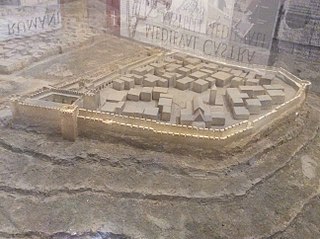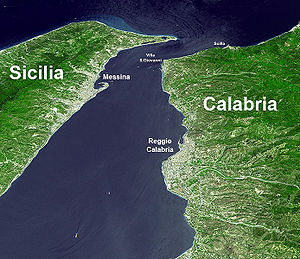
The Aghlabid dynasty was an Arab dynasty centered in Ifriqiya from 800 to 909 that conquered parts of Sicily, Southern Italy, and possibly Sardinia, nominally as vassals of the Abbasid Caliphate. The Aghlabids were from the tribe of Banu Tamim and adhered to the Mu'tazilite rationalist doctrine within Hanafi Sunni Islam, which they imposed as the state doctrine of Ifriqiya. They ruled until 909 when they were conquered by the new power of the Fatimids.

The island of Sicily was under Islamic rule from the late ninth to late eleventh centuries. It became a prosperous and influential commercial power in the Mediterranean, with its capital of Palermo serving as a major cultural and political center of the Muslim world.

Islamic rule in Tripolitania and Cyrenaica began as early as the 7th century. With tenuous Byzantine control over Libya restricted to a few poorly defended coastal strongholds, the Arab invaders who first crossed into Pentapolis, Cyrenaica in September 642 encountered little resistance. Under the command of Amr ibn al-A'as, the armies of Islam conquered Cyrenaica, renaming the Pentapolis, Barqa.
Euphemius or Euphemios was a Byzantine commander in Sicily, who rebelled against the imperial governor in 826 AD, and invited the Aghlabids to aid him, thus beginning the Muslim conquest of Sicily.

The history of Islam in Sicily and southern Italy began with Arab colonization in Sicily, at Mazara, which was captured in 827. The subsequent rule of Sicily and Malta started in the 10th century. The Emirate of Sicily lasted from 831 until 1061, and controlled the whole island by 902. Though Sicily was the primary Muslim stronghold in Italy, some temporary footholds, the most substantial of which was the port city of Bari, were established on the mainland peninsula, especially in mainland southern Italy, though Arab raids, mainly those of Muhammad I ibn al-Aghlab, reached as far north as Naples, Rome and the northern region of Piedmont. The Arab raids were part of a larger struggle for power in Italy and Europe, with Christian Byzantine, Frankish, Norman and indigenous Italian forces also competing for control. Arabs were sometimes allied with various Christian factions against other factions.

The Muslim conquest of Sicily began in June 827 and lasted until 902, when the last major Byzantine stronghold on the island, Taormina, fell. Isolated fortresses remained in Byzantine hands until 965, but the island was henceforth under Muslim rule until conquered in turn by the Normans in the 11th century.
Karbeas, also Karbaias (Καρβαίας), was a Paulician leader, who, following the anti-Paulician pogroms in 843, abandoned his service in the Byzantine army and went over to the Arabs. With the aid of the emir of Melitene, Umar al-Aqta, he founded the Paulician principality of Tephrike, which he ruled until his death in 863. During this period he participated alongside Umar in several raids against the Byzantine Empire.

The Battle of Mauropotamos was fought in 844, between the armies of the Byzantine Empire and the Abbasid Caliphate, at Mauropotamos. After a failed Byzantine attempt to recover the Emirate of Crete in the previous year, the Abbasids launched a raid into Asia Minor. The Byzantine regent, Theoktistos, headed the army that went to meet the invasion but was heavily defeated, and many of his officers defected to the Arabs. Internal unrest prevented the Abbasids from exploiting their victory, however. A truce and a prisoner exchange were consequently agreed in 845, followed by a six-year cessation of hostilities, as both powers focused their attention elsewhere.

The sack of Amorium by the Abbasid Caliphate in mid-August 838 was one of the major events in the long history of the Arab–Byzantine Wars. The Abbasid campaign was led personally by the Caliph al-Mu'tasim, in retaliation to a virtually unopposed expedition launched by the Byzantine emperor Theophilos into the Caliphate's borderlands the previous year. Mu'tasim targeted Amorium, an Eastern Roman city in western Asia Minor, because it was the birthplace of the ruling Byzantine dynasty and, at the time, one of Byzantium's largest and most important cities. The caliph gathered an exceptionally large army, which he divided in two parts, which invaded from the northeast and the south. The northeastern army defeated the Byzantine forces under Theophilos at Anzen, allowing the Abbasids to penetrate deep into Byzantine Asia Minor and converge upon Ancyra, which they found abandoned. After sacking the city, they turned south to Amorium, where they arrived on 1 August. Faced with intrigues at Constantinople and the rebellion of the large Khurramite contingent of his army, Theophilos was unable to aid the city.

The Sack of Damietta was a successful raid on the port city of Damietta on the Nile Delta by the Byzantine navy on 22–24 May 853. The city, whose garrison was absent at the time, was sacked and plundered, yielding not only many captives but also large quantities of weapons and supplies intended for the Emirate of Crete. The Byzantine attack, which was repeated in the subsequent years, shocked the Abbasid authorities, and urgent measures were taken to refortify the coasts and strengthen the local fleet, beginning a revival of the Egyptian navy that culminated in the Tulunid and Fatimid periods.
The siege of Syracuse in 827–828 marks the first attempt by the Aghlabids to conquer the city of Syracuse in Sicily, then a Byzantine province. The Aghlabid army had only months before landed on Sicily, ostensibly in support of the rebel Byzantine general Euphemius. After defeating local forces and taking the fortress of Mazara, they marched on Syracuse, which was the capital of the island under Roman and Byzantine rule. The siege lasted through the winter of 827–828 and until summer, during which time the besieging forces suffered greatly from lack of food and an outbreak of an epidemic, which claimed the life of their commander, Asad ibn al-Furat. In the face of Byzantine reinforcements, the new Arab leader, Muhammad ibn Abi'l-Jawari, abandoned the siege and withdrew to the southwestern part of the island, which remained in their hands. From there they pursued the slow conquest of Sicily, which led to the fall of Syracuse after another long siege in 877–878, and culminated in the fall of Taormina in 902.

The siege of Syracuse from 877 to 878 led to the fall of the city of Syracuse, the Byzantine capital of Sicily, to the Aghlabids. The siege lasted from August 877 to 21 May 878 when the city, effectively left without assistance by the central Byzantine government, was taken by the Aghlabid forces.

The siege of Melite was the capture of the Byzantine city of Melite by an invading Aghlabid army in 870 AD. The siege was initially led by Halaf al-Hādim, a renowned engineer, but he was killed and replaced by Sawāda Ibn Muḥammad. The city withstood the siege for some weeks or months, but it ultimately fell to the invaders, and its inhabitants were massacred and the city was sacked.

The siege of Medina was an unsuccessful Byzantine attack on the Muslim city of Medina, Malta in 1053 or 1054. The Muslim inhabitants of the city and their slaves managed to repel a superior Byzantine force, which retreated with heavy losses. After the siege, the slaves who helped the Muslims against the invaders were freed, and the Byzantines never attempted to retake the island.
Ahmad ibn Ziyadat Allah ibn Qurhub, commonly known simply as Ibn Qurhub, ruled Sicily in rebellion against the Fatimid Caliphate, from 913 to 916. He launched raids against the Byzantine Empire in southern Italy and against the shores of Fatimid Ifriqiya, but was deposed and handed over to the Fatimids, who executed him and his followers in July 916.

The siege of Taormina in 902 ended the conquest of the Byzantine city of Taormina, in northeastern Sicily, by the Aghlabids. The campaign was led by the deposed Aghlabid emir, Ibrahim II, as a form of armed pilgrimage and holy war. Ibrahim's forces defeated the Byzantine garrison in a hard-fought battle in front of the city walls, and laid siege to the city. Left unsupported by the Byzantine government, Taormina capitulated on 1 August. The population was massacred or sold into slavery. The fall of this last major Byzantine stronghold signalled the completion of the Muslim conquest of Sicily, which had been ongoing since the 820s, although some minor Byzantine outposts survived until the 960s.

The siege of Enna or Castrogiovanni was launched by the Aghlabids against the important Byzantine city of Enna in 859. The Aghlabid forces managed to capture the city.
The Battle of Butera happened in late 845 or early 846 between the Aghlabid army and the Byzantine army at Butera, south of Sicily. The Aghlabids achieved a resounding success against the Byzantines.
The Siege of Lentini occurred in 846 or 847 when the Arab Aghlabids attacked and captured the city of Lentini from the Byzantines.












